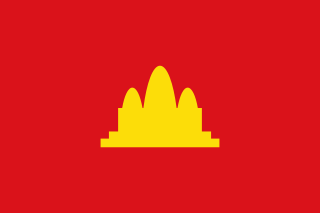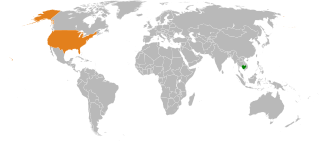Related Research Articles

The French protectorate of Cambodia refers to the Kingdom of Cambodia when it was a French protectorate within French Indochina, a collection of Southeast Asian protectorates within the French colonial empire. The protectorate was established in 1863 when the Cambodian King Norodom requested the establishment of a French protectorate over his country, meanwhile Siam renounced suzerainty over Cambodia and officially recognised the French protectorate on Cambodia.

The Kingdom of Cambodia, also known as the First Kingdom of Cambodia, and commonly referred to as the Sangkum period, refers to Norodom Sihanouk's first administration of Cambodia from 1953 to 1970, an especially significant time in the country's history. Sihanouk continues to be one of the most controversial figures in Southeast Asia's turbulent and often tragic postwar history. From 1955 until 1970, Sihanouk's Sangkum was the sole legal party in Cambodia.
Articles related to Cambodia and Cambodian culture include:

Khieu Samphan is a Cambodian former communist politician and economist who was the chairman of the state presidium of Democratic Kampuchea (Cambodia) from 1976 until 1979. As such, he served as Cambodia's head of state and was one of the most powerful officials in the Khmer Rouge movement, although Pol Pot remained the General Secretary in the party.
During the Cold War, the Indochina Wars were a series of wars which were waged in Indochina from 1946 to 1991, by communist forces against the opponents. The term "Indochina" referred to former French Indochina, which included the current states of Vietnam, Laos, and Cambodia. In current usage, it applies largely to a geographic region, rather than to a political area. The wars included:

The Cambodian–Vietnamese War was an armed conflict between Democratic Kampuchea, controlled by Pol Pot's Khmer Rouge, and the Socialist Republic of Vietnam. The war began with repeated attacks by the Liberation Army of Kampuchea on the southwestern border of Vietnam, particularly the Ba Chúc massacre which resulted in the deaths of over 3,000 Vietnamese civilians. On 23 December 1978, 10 out of 19 divisions of Khmer Rouge's military divisions opened fire along the shared Southwestern borderline with Vietnam with the goal of invading the Vietnamese provinces of Đồng Tháp, An Giang and Kiên Giang. On 25 December 1978, Vietnam launched a full-scale invasion of Kampuchea, and subsequently occupied the country in 2 weeks and removed the government of the Communist Party of Kampuchea from power. In doing so, Vietnam put an ultimate stop to the Cambodian Genocide, which had most likely killed between 1.2 million and 2.8 million people — or between 13 and 30 percent of the country’s population.
Each "article" in this category is a collection of entries about several stamp issuers, presented in alphabetical order. The entries are formulated on the micro model and so provide summary information about all known issuers.
Each "article" in this category is a collection of entries about several stamp issuers, presented in alphabetical order. The entries are formulated on the micro model and so provide summary information about all known issuers.

The Khmer Issarak was a "loosely structured" anti-French and anti-colonial independence movement. The movement has been labelled as “amorphous”. The Issarak was formed around 1945 and composed of several factions, each with its own leader. Most of the Issarak factions fought actively between the end of the Second World War in 1945 and Cambodia’s independence in 1953. The initial objective of the Khmer Issarak was to fight against the French in order to gain independence, before later focusing on overthrowing the Cambodian government. The term Issarak originally referred to non-communist, but in the early 1950s the Việt Minh-guided guerrillas branded themselves Issaraks for the sake of unifying other non-communist forces.

Kampuchea, officially Democratic Kampuchea (DK) from 1976 onward, was the Cambodian state from 1975 to 1979, under the totalitarian dictatorship of Pol Pot and the Communist Party of Kampuchea (CPK), commonly known as the Khmer Rouge (KR). It was established following the Khmer Rouge's capture of the capital Phnom Penh, effectively ending the United States-backed Khmer Republic of Lon Nol. After Vietnam took Phnom Penh in 1979, it was disestablished in 1982 with the creation of the CGDK in its place.

The National Bank of Cambodia is the central bank of Cambodia. The bank's duties include, inter alia, the management of monetary and exchange policies, the regulation of banks and financial institutions, and the control of the national currency, the riel. The bank was established in 1954, after Cambodia obtained its independence from France, taking over from the Institut d'Émission des États du Cambodge, du Laos et du Viet-nam, a short-lived French quasi-central bank that had itself replaced the Banque de l'Indochine two years earlier.
The earliest traces of armed conflict in the territory that constitutes modern Cambodia date to the Iron Age settlement of Phum Snay in north-western Cambodia.

Bilateral relations between the United States and Cambodia, while strained throughout the Cold War, have strengthened considerably in modern times. The U.S. supports efforts in Cambodia to combat terrorism, build democratic institutions, promote human rights, foster economic development, eliminate corruption.

Cambodia–Vietnam relations take place in the form of bilateral relations between the Kingdom of Cambodia and the Socialist Republic of Vietnam. The countries have shared a land border for the last 1,000 years and share more recent historical links through being part of the French colonial empire. Both countries are members of the Association of Southeast Asian Nations (ASEAN).
The Japanese occupation of Cambodia was the period of Cambodian history during World War II when the Kingdom of Cambodia was occupied by the Japanese. Vichy France, which was a client state of Nazi Germany, nominally maintained the French protectorate over Cambodia and other parts of Indochina during most of the Japanese occupation. This territory of Cambodia was reduced, by concessions to Thailand after the Franco-Thai War, so that it did not include Stung Treng Province, Battambang Province, and Siem Reap Province.

Cambodia–Japan relations are foreign relations between Cambodia and Japan. Japan has an embassy in Phnom Penh and Cambodia has an embassy in Tokyo.

This is a survey of the postage stamps and postal history of Laos.

The Communist Party of Kampuchea (CPK), also known as the Khmer Communist Party, was a communist party in Cambodia. Its leader was Pol Pot, and its members were generally known as the Khmer Rouge. Originally founded in 1951, the party was split into pro-Chinese and pro-Soviet factions as a result of the Sino–Soviet split with the former being the Pol Pot faction, and the latter adopting a more revisionist approach to Marxism. As such, it claimed that 30 September 1960 was its founding date; it was named the Workers' Party of Kampuchea before it was renamed the Communist Party in 1966.

Khmer nationalism is a form of nationalism found in Cambodia, that asserts that Khmers (Cambodians) are a nation and promotes the cultural unity of the Khmer (Cambodian) race.

The Cambodia–Vietnam border is the international border between the territory of Cambodia and Vietnam. The border is 1,158 km in length and runs from the tripoint with Laos in the north to Gulf of Thailand in the south.
References
- ↑ "Cambodia | Stamps and postal history | StampWorldHistory". Archived from the original on 2018-03-03. Retrieved 12 August 2018.[ title missing ]
- ↑ Stamps of the World. Stanley Gibbons. 2004. p. 537.